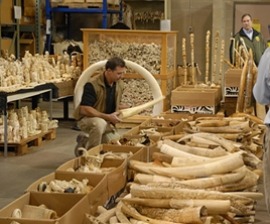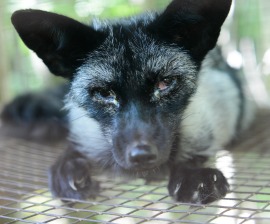NEW DELHI—In a historic move for animals across the country, the Ministry of Environment, Forest & Climate Change (MoEFCC) has notified four rules under the Prevention of Cruelty to Animals Act, 1960 to regulate dog breeding and marketing, livestock market, case property animals and fish tank and aquarium. The MoEFCC notified the rules in the wake of a series of representations made by Humane Society International/India and People for Animals in addition to directions from the judiciary for establishment of some of the rules.
Help us achieve more victories for animals.
Dog Breeding & Marketing Rules are to regulate the breeding industry where tens of thousands of dogs are bred in deplorable conditions without proper medical care. Most often than not unweaned puppies less than 2 months of age are sold to unassuming customers without any registration or records. Whelping mothers are impregnated continuously that impacts their own health and the wellbeing of the puppies born.
Livestock market rules will regulate all of India’s live animal markets. Some of the largest cattle markets are hosted by Bihar, Rajasthan, Uttar Pradesh, Maharashtra, Tamil Nadu and Andhra Pradesh every year. Estimates suggest that hundreds of thousands of animals including cows, bulls, buffaloes, horses, goats, sheep, donkeys, camels and birds are transported in deplorable conditions with no access to food, water or rest to be traded at live markets The cruel and illegal cattle trafficking taking place at these markets led HSI Government Affairs Lliaison Gauri Maulekhi to seek the Hon’ble Supreme Court’s intervention. After the court directed the Government of India to regulate these markets, the Animal Welfare Board of India drafted a recommendation of rules to the MoEFCC.
Gauri Maulekhi, trustee at PFA and government affairs liaison for HSI/India said, “This is a huge step forward for animals. We commend the Ministry for their vision and their efforts to protect the most vulnerable animals, be it animals that are used as reproductive machines in the breeding industry or animals that are cruelly transported to be sold off at unregulated markets. The battle is only half won though. The real change will come when these rules are strictly followed and implemented and we will work with the law enforcement agencies through capacity building to ensure they are.”
Some of the key features of these four rules are as follows:
Dog Breeding & Marketing Rules
1. The rules mandate the obtaining of a certificate of the registration from the Animal Welfare Board of India for breeding activity, owning or housing dogs for breeding, for sale for dogs and pups. Such a certificate shall be valid for a period of 1 year, nontransferable and shall be subject to reviewing.
2. Application for registration to be made to the State Board with a non-refundable fee of 5000 INR. A separate application shall be made for every establishment intended to be used for breeding or housing dogs for breeding.
3. On receipt of application the establishment sought to be registered shall be inspected by an authorized team and on being satisfied that the applicant and the establishment comply with requirements under these rules, the State Board shall recommend the application for registration to the board. The Board may issue the certificate of registration based on such recommendation. Where recommendation is not made for certification, the State Board shall provide reasons in writing to the applicant. An applicant may prefer an appeal to the Central Government if agreed by the decision of the Board.
4. Rule 8 confers certain responsibilities on every breeder to ensure the mental and physical wellbeing of the dogs used for breeding and the ones that are sold.
5. The rules require the breeder to maintain records of all the animals housed in the establishment including the dogs being used for breeding and the dogs for sale. The breeder shall also maintain records of each individual dog.
6. Every registered breeder is required to submit an annual report to the Board detailing total number of animals traded (sold or exchanged or rehomed), boarded or exhibited during the previous year.
7. No establishment being used or intended to be used for breeding or housing dogs for breeding shall be granted any license by the local authority unless the breeder (owner of such establishment) holds a certificate of registration as under these rules.
Regulation of Livestock Market Rules
1. Animal market monitoring committees at state and district levels will implement the rules and supervise livestock markets. They will also identify and register existing animal markets. Proposed new markets must also submit blueprints to the District Committee prior to being established.
2. These committees shall ensure that markets provide housing, sufficient food and water, feed storage areas, water troughs, ramps, enclosures for sick animals, veterinary care, lighting, bedding, toilets, proper drainage and other facilities.
3. No animal market shall be allowed in a place that is situated within 30 kilometres from any state border or that is situated within 100 kilometres from any international border.
4. State animal welfare boards will issue directions for compliance of these rules, authorize inspections of animal markets and seize animals from non-complying markets.
5. Every market is to have an adequate veterinary facility, supervision of animals being loaded and unloaded, verification of the transport document, and a system of monitoring the handling of animals at the market. The veterinary inspector shall maintain records of all animals inspected and treated as well as the number of transport permits issued, the number of animals found unfit for transport, and action initiated when an animal found unfit for transport is transported.
6. Unfit animals, pregnant animals, animals who have not been vaccinated and animals under six months of age cannot be displayed or sold at the market. Persons in charge of the animals are liable for their well-being.
7. These rules prescribe methods of handling, controlling and penning or caging of animals in a manner that prevents unnecessary pain or suffering.
8. Unfit animals are required to have separate accommodation. For identification purposes, a veterinary assistant may mark an animal with convenient methods such as ear tags.
9. A District Magistrate or Collector will enforce these rules. If either the District Magistrate or Collector finds that a market is in breach of these rules, he or she may direct closure of such market.
Care & Maintenance of Case Property Animals Rules
1. Pending Litigation Magistrate may direct animals to be housed at the SPCA, AWOs, Pinjrapole, Gaushalas. The cost of their maintenance shall be affixed by State Animal Welfare Board and the same be revised on April 1st of every year. These rates shall be the minimum prescribed rates and must be adhered to. If cost is not provided for a certain animal, it shall be fixed by the local authority based on inputs from the SPCA.
2. The Magistrate shall direct the accused and the owner to execute a bond of a determined value with sureties within 3 days. Execution of additional bond with sureties may be called for. If vehicle is involved in an offence, it shall be held as surety.
3. In case owner and accused are unable to undertake the cost, magistrate shall direct local authority to furnish cost recover the same as revenue arrears.
4. The Magistrate shall also direct local authority to undertake cost where offence is made out but the accused/owner is unidentified. It shall be deemed that the owner has relinquished the ownership of the animal. The relinquishment of ownership, even when voluntary shall have no effect on any criminal charges against the unknown offender and/or the owner.
5. Upon conviction, Magistrate shall deprive that person from the ownership of animal and the animal shall be given to the entity already having custody for adoption or other disposition. If accused is found not guilty, the animal may be returned only if the accused /owner can demonstrate to the satisfaction of the court that sufficient care will be provided to the animal. Unused portion of the bond executed shall be returned but used portion cannot be recovered.
6. Persons charged under the act or under any state cattle preservation acts shall be prohibited from adopting animals from any such entities which undertake custody of case property animals.
Aquarium and Fish Tank Animals Shop Rules
1. No aquarium or fish shop shall source fish tank animals caught by destructive fishing practices such as bottom trawling, cyanide fishing, use of explosives or dynamite to kill or stun fish, those trapped from coral reefs or from any protected areas.
2. The rules require every aquarium to acquire recognition and fish shop to acquire registration from Animal Welfare Board of India.
3. Rules prohibit aquariums & fish shops from keeping, housing, displaying and trade of cetaceans, penguins, otters, manatees or sea or marine turtles, artificially coloured fish, species protected under Wildlife Protection Act, 1972, species listed under Appendix I in CITES and over 150 species listed in Scheduled II of the rules
4. No aquariums will be allowed in public areas such as airports, pubic offices, railway stations or schools nor in markets or exhibitions where permanent facilities are not available.
5. Prerequisite for recognition is submitting application to the state board along with the blue print and collection plan. Certification for obtaining recognition an aquarium is required to submit a master plan (blue print and collection plan) to the state animal welfare board. The recognition from AWBI is subject to approval of the state board as well as itself. Recognition to be renewed every 2 years.
6. The rules prescribe, for aquariums, standards for a veterinary and infrastructure facilities. They mandate maintenance of inventory (record of births, acquisitions, deaths), feed register and health register; fish shops in addition to aforementioned records shall maintain an inventory of animals traded (sold, bought exchanged) during the previous year.
7. Rules prohibit physical handling or performances by fish tank animals as educational activity.
8. Noncompliance of the rules by aquarium will result in de-recognition and consequently sealing of aquarium by the local authority. Animals confiscated from such aquarium are required to be handed over to a recognized aquarium or be released into their natural habitat. Noncompliance of the rules or failure to apply for the registration within stipulated time will result in the sealing of the fish shop by the local authority upon recommendation of the State Board. Animals confiscated from such shops shall be handed over to a recognized aquarium.
9. Certain common provisions for aquariums and fish shops with regard to housing and display prohibits display of fish tank animals in bowls or in tanks of the capacity of 60 litres or less. These provisions prescribe conditions for maintenance of fish tanks, enrichment to be provided in fish tanks and standards for upkeep and healthcare of fish tank animals.
Media Contact: Alokparna Sengupta, email: asengupta@hsi.org mobile: +919849094113













